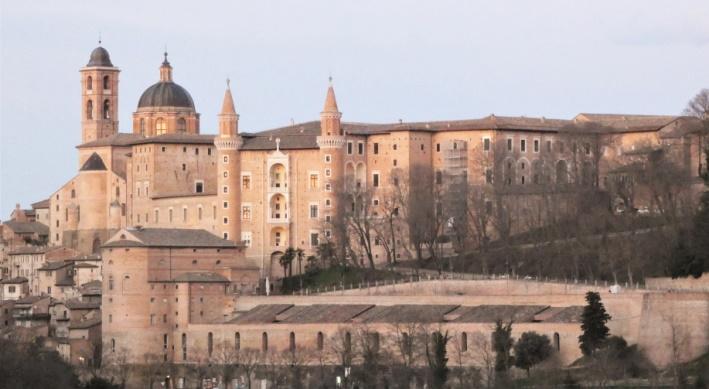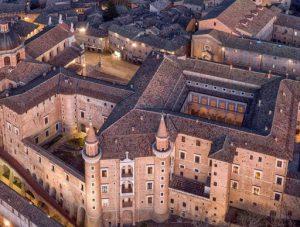
(English version at the bottom).
Nel Palazzo Ducale di Urbino, il tratto di muro che va dalle torri, i Torricini, al lato sinistro del fabbricato vicino al Duomo, custodisce al suo interno il Giardino Pensile che unisce gli appartamenti del Duca con quelli della Duchessa. La tradizione urbinate vuole che tale muro fosse servito al Duca Federico per raggiungere la moglie quando voleva passare con lei la notte. Verità o leggenda? Protendo per la leggenda, in quanto non vedo perché il Duca avrebbe dovuto far visita alla Duchessa di nascosto, visto che era la moglie. Tutt’al più avrebbe potuto usufruire del passaggio come scorciatoia senza attraversare un palazzo davvero grande. Ma ciò si racconta e lasciamo che sia così, per una volta salviamo l’aspetto romantico.
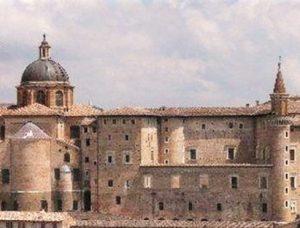
Come noto il Palazzo Ducale di Urbino, fortemente voluto dal duca Federico III da Montefeltro intorno agli anni Settanta del 1400, è uno dei maggiori complessi architettonici del Rinascimento Italiano. Architettura complessa e grandiosa, benché incompiuta rispetto i disegnai del Duca, conserva, tra l’altro, al suo interno un cortile trapezoidale adibito a giardino pensile. Esso si apre sul panorama collinare e appenninico attraverso grandi finestre e è collocato sopra grandi e innovativi, per il tempo, ambienti di servizio quali magazzini, lavanderie, stalle, cucine, bagni e una grande ghiacciaia per la conservazione degli alimenti. Il giardino è da considerarsi un’opera eccezionale nel panorama artistico-architettonico del periodo e lo si può reputare l’antesignano di una vera e propria moda che invaderà il Rinascimento italiano: la costruzione di un giardino all’interno delle corti nobili.
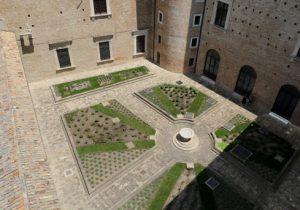
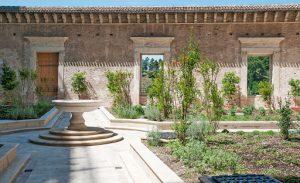
L’aspetto attuale del giardino non è tuttavia quello originale essendo stato rimaneggiato con interventi spesso discutibili nel XIX secolo. Soprattutto durante gli anni ‘80 di quel secolo sono state aggiunte cinque aiuole di dimensioni notevoli e sopraelevate, senza far troppo caso alla decorazione floreale e vegetale che dovevano contenere. Non essendoci documenti storici che informano sulla tipologia delle piante presenti originariamente, ultimamente, si è provveduto a cercare di ripristinare la vegetazione secondo l’iconografia naturalistica presente nel palazzo o riferendosi alle informazioni pervenute su altri guardini del ducato dello stesso periodo. Ne è venuto che, come in uso nelle corti rinascimentali, hanno avuto la predilezione piante che non avevano solo una funzione decorativa, ma utilizzate anche per altri fini, come quello alimentare o farmaceutico, o ancora piante impiegate per scopi decorativi, ad esempio per la realizzazione di festoni o corone celebrative, piante con un valore simbolico (c’è stato un largo uso della granata, del melograno, dei garofani).
Insomma il giardino pensile del Palazzo Ducale di Urbino, al di là della leggenda e delle tradizioni locali, rimane un esempio insostituibile di un parte dell’arte e dell’estetica forse troppo spesso trascurata, quella dei giardini, anche se in Urbino dovrebbe essere ancora presente la suggestione del proverbiale lavoro sul tema che ha caratterizzato il pensiero estetico del Prof. Rosario Assunto, in particolare il memorabile testo Ontologia e teleologia del giardino, da troppi già dimenticato.
CURIOSITY IN ART.
In the Ducal Palace of Urbino, the stretch of wall that goes from the towers, the Torricini, to the left side of the building near the Duomo, houses the Giardino Pensile (the roof garden) that connects the Duke’s apartments with those of the Duchess. The tradition of Urbino, birthplace of Raffaello Sanzio, has it that this wall was served to Duke Frederick to reach his wife when he wanted to spend the night with her. Truth or legend? Protecting for legend, as I do not see why the Duke should have visited the Duchess secretly, since he was his wife. At best he could have taken advantage of the passage as a shortcut without crossing a really big building. But this is told and let it be so, for once we save the romantic aspect (picture 1).
As is known, the Doge’s Palace of Urbino, strongly desired by Duke Federico III da Montefeltro around the seventies of the 1400s, is one of the major architectural complexes of the Italian Renaissance. Complex and grandiose architecture, although unfinished compared to the Duke’s designs, preserves, among other things, a trapezoidal courtyard used as a hanging garden. It opens onto the hilly and Apennine panorama through large windows and is placed above large and innovative, for the time, service environments such as warehouses, laundries, stables, kitchens, bathrooms and a large glacier for food conservation. The garden is to be considered an exceptional work in the artistic-architectural expression of the period and can be considered the forerunner of a real fashion that will invade the Italian Renaissance: the construction of a garden inside the noble courtyards (picture 2-3)
The current appearance of the garden is not, however, the original one having been reworked with interventions often questionable in the 19th century. Especially during the 80s of that century five flower beds of considerable size and elevated were added, without too much notice to the floral and vegetable decoration that they were to contain. Since there are no historical documents that inform about the type of plants originally present, lately, an attempt has been made to restore the vegetation according to the naturalistic iconography present in the palace or referring to the information received on other gardens of the duchy of the same period. It turned out that, as in use in Renaissance courts, plants that not only had a decorative function, but also used for other purposes, such as food or pharmaceutical, or plants used for decorative purposes, for example for the realization of celebratory festoons or crowns, plants with a symbolic value (there was a wide use of grenade , pomegranate, carnations).
In short, the hanging garden of the Doge’s Palace of Urbino, beyond the legend and local traditions, remains an irreplaceable example of a part of art and aesthetics perhaps too often neglected, that of the gardens, although in Urbino the suggestion of the proverbial work on the theme that characterized the aesthetic thought of Prof. Rosario Assunto should still be present, in particular the memorable text Ontologia e teleologia del giardino (Ontology and Teleology of the garden), by too many already forgotten.

